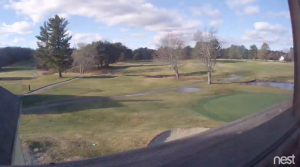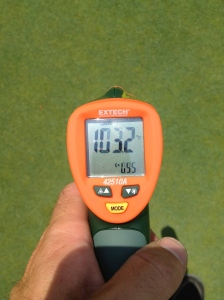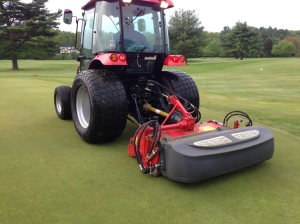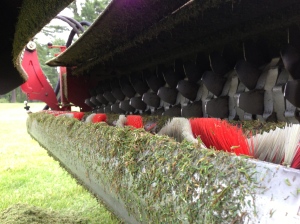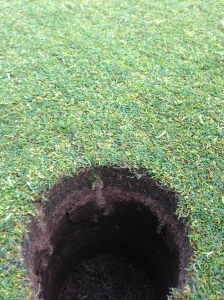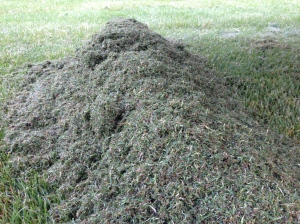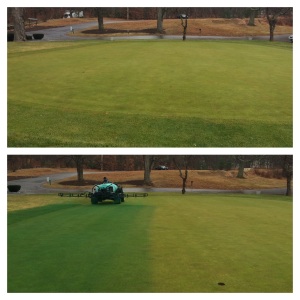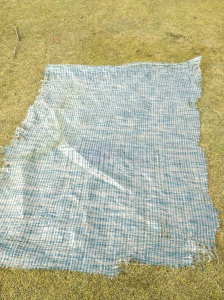Last week, we saw a “dusting” or a few inches of snow. That first snow of the season is always exciting. The way it just blankets everything with white. It gives a sense of peace and clean all over. When managing turf, snow can be very helpful. It coats and insulates to protect from desiccation. It keeps the temperature at 32°F. It helps protect from foot traffic damaging to the leaf blades. It even helps protect from a falling tree whether it be weather related or man made. However, the snow we received last week was bad. It started as snow, but turned over to rain and resulted in ice. This ice, if left for a long period of time, could potentially suffocate the turf plant. Some precautions can be taken and have been taken such as removing certain trees, topdressing greens, and coating the greens with black sand or sunflower seeds if ice is present. Luke Bryan says it best in his hit country song, but it really is applicable to our golf course right now. Rain really is a good thing! The rain yesterday has completely cleared our course. In fact, it looks great! If you’re looking to play, please call the proshop ahead of time for details!
Tag Archives: turf
Greens “watering”…
It is finally that time of year again where maintenance is becoming routine. We have reached a point in our maintenance schedule that has allowed us to get caught up with many areas on the two courses. While you will definitely see some projects that are ongoing; both courses have reached a maintenance level. This is all thanks to the extreme effort that our staff has put in over the last two months!
Over the next few weeks as the temperatures become consistently warm, you will notice staff members syringing the greens with hoses. Yes, we do have sprinklers and yes, we do water at night. However, overhead water can sometimes cause more harm than benefit. When temperatures get hot, and even more importantly the humidity increases, overhead is too much water and plays a significant role in disease pressure. Another downside to overhead water is that it isn’t able to really focus on the tiny little micro climates all over the greens. The hoses allow us to carefully monitor the moisture level and surface temperature level. We are proactively monitoring soil moisture with our TDR 100 moisture meters and constantly surveying the greens. We are not actually watering the greens, but simply cooling the surface atmosphere right above the plant. This practice, although labor intensive, ensures firmer, faster greens and less disease pressure. You will also notice us changing cups frequently throughout the afternoon. This is another proactive solution to minimizing foot traffic and turf stress. Please watch this short USGA video on hose watering:
The staff does not spend any longer than 3 minutes on a green surface. If you happen to be waiting to hit your approach, please wait just a few seconds longer to avoid hitting into them. They are paying attention to you, but they are diligently working to keep the green surfaces alive and playing well. Thank you for your understanding and patience. See you on the course!
-Jason VanBuskirk, Superintendent
A Necessary Evil… (Not aeration)
Last week, you saw a process get done to the putting greens that was done this time last year. In simple terms, we dethatched the greens. Although the concept is similar to aeration in the spring time, it certainly doesn’t take the place of it. In fact, it removes more surface material than a traditional aerator would. It allows for each putting green to be treated with sand and it gives the sand a little slit to nestle into. The machine is called a Rotadairon. A very detailed explanation can be seen here on their website. The service was provided by Mike Parks from Hillcrest Turf Services (http://www.hillcrestturfservices.net) located right here in Massachusetts. The purpose of running this machine over all 39 greens is to remove the “thatch” layer that builds up over the duration of multiple golf seasons. Although we aerate the greens every year, that machine only pokes holes and removes material 2″ on center (process can be read about here). Sand is then applied to fill the holes in. However, the Rotadairon cuts into the surface approximately 0.5″ – 0.75″ over a 53″ width. It collects and removes all of the thatch material allowing for immediate air exchange to the roots and improved surface drainage. During the process last week, we mowed the greens, ran the Rotadairon, mowed the greens again to remove the very little debris left behind, blew off the collars, rolled the green, topdressed, fertilized, and watered-in. The topdressing sand is a 1mm sand. This is used because it has a much larger pore space than thatch or traditional soil. The sand will allow for the bent-grass plants to continue to creep and become more dense. This week, we are topdressing again and fertilizing again with a slightly different material. Overall, the achieved result is a firmer, faster, healthier putting green. With the right weather, the greens will be near perfect again by the weekend. Apologies for the short inconvenience. Below, are a few pictures and videos of the machine in action! See you on the course!
-Jason VanBuskirk, Superintendent
Golf in the Winter…
Although I posted this last December, it is very applicable to conditions right now. Truthfully, not much changes when winterizing the golf courses. Enjoy.
The winter season is upon us, or is it? We can only hope that the snow falling across the blog screen that you are reading right now would be falling on the actual golf course some time soon. Both courses are fully winterized, well, minus the snow accumulation. The irrigation systems have been blown out, drains have been flushed/open, accessories have been removed for refurbishing, snow mold applications have been applied to greens/tees/fairways, Winter Green has been applied to all 39 greens, and two pin positions have been cut on the front 9 of both courses. Yes, two pin positions. I got this brilliant idea from Russ Heller, a fellow Superintendent here in Massachusetts. Russ also has a great blog seen here: William Devine Golf Course at Franklin Park. Well, the theory behind it is to divert foot traffic on frozen/dormant greens surfaces. Closing the greens or providing temporary greens is not something we do at Stow Acres. This is where snow is helpful in covering the greens, but, in order to preserve playing conditions for the Spring season until snow falls, we cut two pins. We will leave pins in both hole locations allowing the golfer to pick whichever hole location they desire. Once on the green, traffic will be split between both hole locations. We’re doing this primarily because we suffered minor turf damage last season from repetitive foot traffic around one hole location pictured below.
The turf does heal once the weather gets warmer, but as you can imagine, these spots took quite a bit longer to recover. Our assistant superintendent, Kevin Bracken, had a great idea to place modified greens covers over the trampled spots once we could cut the cup in a new position. This certainly accelerated recovery.
Currently, there is no “real” snow in the immediate forecast. However, with the cold temperatures becoming more consistent, we will be covering both practice greens tomorrow to ensure great putting conditions for the Spring. If you plan on playing until it snows, please be mindful of the frozen turf. Greens are most susceptible, so keeping pull carts in the rough and walking on the greens as little as possible will help preserve the surface. I will leave you with a picture of what even foot traffic/pull-cart can do to fairway turf during a frozen morning. Stay warm, play well, and have a great holiday season!
-Jason VanBuskirk, Superintendent
More on Frost Delays… Yes, they are necessary.
While the temperatures have been generously warm so far this Fall, we are entering a significant drop this week, with maybe even some snow mixed in tomorrow morning. The video below is brought to you by the courtesy of Dr. Larry Stowell from PACE Turf. He helps explain frost delays in simple terms to the everyday golfer. Thanks Dr. Stowell! Enjoy!
-Jason VanBuskirk, Superintendent
The first significant Fall frost…
Frost delay is a term that will become common as the season starts nearing to an end. These delays can sometimes be brief, but can also last as long as 3-4 hours depending on how quick and warm the atmosphere gets. Frost is something that can be very damaging to grass especially when it is driven on or it sees a lot of traffic. Frost forms even when temperatures are not necessarily at 32F. If the sky is clear at night or early in the morning, a process called radiational cooling takes place. This is when the earth loses heat and moisture trying to balance the earth’s energy. Through evapotranspiration, the plant also loses moisture to the atmosphere. If the temperature is cool enough, the cells inside the plant tissue start to freeze. If the plant is walked or driven on, the cells can burst and potentially kill the plant. This is why black tracks are typically seen in late Fall going across a fairway, tee, or even sometimes, a green. Thanks to the GCSAA for this published article. Please click on the link for more information, GCSAA Frost Delay Announcement
I understand that frost delays can be very frustrating, especially if you typically play early in the morning. However, I ask for your patience and cooperation during these delays. It is definitely for the health and playability of the turf. We also ask for your cooperation in obeying the signs on both practice greens. I understand that walking is still allowed on the courses during a frost, but the practice greens typically see almost 50x the amount of traffic than regular greens. Practicing on these greens during a frost delay could result in severe turf injury or even death. We aggressively monitor the conditions and allow carts and traffic to resume on the turf as quickly as possible. Thanks for your understanding! See you on the course!
-Jason VanBuskirk, Superintendent
Pin Placements…
Many of you have been questioning the position of some of the pin placements over the last few weeks. Well, the answer is, we like to make it tough! Just kidding…The real reason that some of the pin placements have been in obscure spots is to give the majority of the green a break from repeated foot traffic. Yes, we have finished aeration, and the greens have returned to normal or better condition, but to keep them that way you will see pins being placed on the outskirts of the greens, or on ridges and hills; areas that you don’t normally see a pin. September and October are perfect months for healing turf, so, why not give some of the usual areas a much-needed break from the long golf season? I apologize for three putts and missed greens. Normal pin positions will return soon! See you on the course!
-Jason VanBuskirk, Superintendent
Greens Aeration Complete!
Yesterday afternoon was the completion of Fall greens aeration here at Stow Acres. Although very relieved to have the process over with, it marks the start of an exciting Fall. Getting greens punched this early in the season will allow us to carry out more improvements on the facility than usual. As a reminder, the North greens were aerated last week on Monday (August 26) and Tuesday (August 27). They are healed in and getting double cut today. South greens and both practice greens were aerated Wednesday (September 4) and Thursday (September 5). I know some are questioning why we don’t aerate only one practice green at a time. The answer is quite simple in that both practice greens operate off of the South course irrigation. It is much easier to control them together with the same watering program than to split them up. With this current weather pattern, we are sure to have the South greens healed within a week. Thanks for your patience. I know I’ve posted this multiple times, but the procedure doesn’t really change. Click here for an in-depth look at the process. Featured below are some pictures from this Fall’s aeration. See you on the course!
-Jason VanBuskirk, Superintendent
A look into the greatness of Cascade…
It was only a few posts ago (Treating the soil) that I explained about treating the soil with “rinse-in” sprays. These sprays are the backbone of our program throughout the year just like the soil is the backbone of the playing surfaces. Without strong , healthy soils, the plants up top don’t do very well. This summer has been quite the test, but with the help of some fantastic products, we’ve been able to deliver nutrients and water to the roots in a quicker and more stable route. Thanks to GCSAAtv for filming this short segment and especially thanks to Precision Laboratories for manufacturing products that we could not live without!
-Jason VanBuskirk, Superintendent
[youtube https://youtu.be/UtKkt63_o60]Treating the soil…
This morning, you may have seen the greens being sprayed and then immediately getting watered. This is an effort to treat the soil with a few different products. By watering the greens right after the spray, not only does it hydrate the plant, but helps move the necessary bio-stimulants, soil nutrients, and wetting agents down to the roots and into the soil profile. We try to stick to a schedule of once a month with the same spray ingredients, plus or minus some soil nutrients. This whole process allows the roots to be fed during the summer heat stress and it allows water to move off the surface and into the root zone. A phrase taken from a wise mentor, “Standing water heats, moving water cools.” This helps summarize the reason for today’s spray, even when the high will be in the low 90s. Stay cool and hydrated, I know my greens certainly will be!
-Jason VanBuskirk, Superintendent


